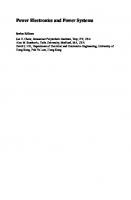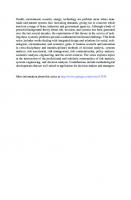Resilience and Stability of Ecological and Social Systems 3030545598, 9783030545598
This monograph, co-authored by three longtime collaborators, aims to promote the interdisciplinary field of mathematical
317 8 7MB
English Pages 157 [165] Year 2020
Table of contents :
Foreword
Preface
Acknowledgements
Contents
1 Understanding Ecosystem Stability and Resilience Through Mathematical Modeling
1.1 The Interface Between Mathematics and Biology
1.2 The Significance of Environmental and Ecological Change: Stability and Resilience
1.3 System Changes that Can Lead to a Loss of Stability and Resilience in Ecosystems
1.4 Understanding Ecological Stability and Resilience: Our Modeling Approach
References
2 The Importance of Life History and Population Interactions in Population Growth
2.1 Background
2.1.1 Model Formulation
2.1.2 Simulation of Population Growth and Main Predictions
2.2 Interactions Between Populations
2.2.1 The Importance of Population Interactions
2.2.2 A Top-down Population Interaction Model
2.2.3 A Bottom-up Population Interaction Model
References
3 Habitat Fragmentation
3.1 Background
3.2 An Individual- (Agent-) Based Model of Habitat Fragmentation
3.2.1 Description of the Model
3.2.2 The Effect of Compartmentalization and Connectedness of the Habitat on the Stabilityof the System
3.2.3 The Emergence of Waves in Space and Time
References
4 Forest Fires: Fire Management and the Power Law
4.1 Background
4.2 An Individual- (Agent) Based Model of Forest Fire
4.2.1 Description of the Model
4.2.2 The Effect of Fire on Plants and Animals
4.3 Power-Law Analysis of the Distribution of Fires
4.3.1 Methods
4.3.2 Size Distribution of Fires in the Habitat
4.3.3 Practical and Theoretical Conclusions
References
5 Material Flow, Task Partition, and Self-Organization in Wasp Societies
5.1 Background
5.1.1 Task Partitioning
5.1.2 The Per capita Paradox
5.1.3 Regulation of Task Partitioning in Metapolybia Wasps
5.2 A System Dynamic Model of Task Partition in Social Wasps
5.2.1 Description of the Model
5.2.2 The Emergence of Task Allocation and the Steady Construction
5.3 The Cost of Task Switching: A Model with Time Delays
5.3.1 Rationalizing the Complication of a New Model
5.3.2 Description of the Model
5.3.3 The Effect of Noise and the Emergence of Periodic Attractors
5.3.4 Effects of Noise and Task Switch Rate on Colony-Level Performance
5.4 Agent-Based Models of Task Partition in Social Wasps: Task Fidelity and Colony Size
5.4.1 Description of the Model
5.4.2 Predictions of the Model
References
6 Ants and Bees: Common Stomach Regulation Provide Stability for Societies
6.1 Background
6.2 Task Allocation in the Colony of Ectatomma ruidum Ants
6.2.1 The Regulatory Role of Density of Prey and Dead Corpses
6.2.2 A Common Stomach Model of the Ants
6.2.3 Predictions of the Ant Model
6.3 Task Allocation of Foraging in Honeybees
6.3.1 Regulation Mechanisms in Honeybees
6.3.2 The Common Stomach Model for Honeybees
6.3.3 Predictions of the Bee Model
References
7 Generalization of the Common Stomach: Integral Control at the Supra-Individual Level
7.1 Background
7.2 Insect Societies and the Common Stomach
7.3 Model of the Common Core of the ``Common Stomach'' Regulation Mechanism
7.4 Properties of the Common Core Regulation Mechanism
7.5 Common Stomach Regulation as a Circuit Model
7.5.1 Description of the Model
7.5.2 Predictions of the Circuit Model
7.6 The Importance and Evolutionary Significance of Common Stomach Regulation
References
A Modeling Techniques
A.1 Population Growth Models Using Differential Equations
A.2 Agent-Based Models of Population Growth
References
Index
Foreword
Preface
Acknowledgements
Contents
1 Understanding Ecosystem Stability and Resilience Through Mathematical Modeling
1.1 The Interface Between Mathematics and Biology
1.2 The Significance of Environmental and Ecological Change: Stability and Resilience
1.3 System Changes that Can Lead to a Loss of Stability and Resilience in Ecosystems
1.4 Understanding Ecological Stability and Resilience: Our Modeling Approach
References
2 The Importance of Life History and Population Interactions in Population Growth
2.1 Background
2.1.1 Model Formulation
2.1.2 Simulation of Population Growth and Main Predictions
2.2 Interactions Between Populations
2.2.1 The Importance of Population Interactions
2.2.2 A Top-down Population Interaction Model
2.2.3 A Bottom-up Population Interaction Model
References
3 Habitat Fragmentation
3.1 Background
3.2 An Individual- (Agent-) Based Model of Habitat Fragmentation
3.2.1 Description of the Model
3.2.2 The Effect of Compartmentalization and Connectedness of the Habitat on the Stabilityof the System
3.2.3 The Emergence of Waves in Space and Time
References
4 Forest Fires: Fire Management and the Power Law
4.1 Background
4.2 An Individual- (Agent) Based Model of Forest Fire
4.2.1 Description of the Model
4.2.2 The Effect of Fire on Plants and Animals
4.3 Power-Law Analysis of the Distribution of Fires
4.3.1 Methods
4.3.2 Size Distribution of Fires in the Habitat
4.3.3 Practical and Theoretical Conclusions
References
5 Material Flow, Task Partition, and Self-Organization in Wasp Societies
5.1 Background
5.1.1 Task Partitioning
5.1.2 The Per capita Paradox
5.1.3 Regulation of Task Partitioning in Metapolybia Wasps
5.2 A System Dynamic Model of Task Partition in Social Wasps
5.2.1 Description of the Model
5.2.2 The Emergence of Task Allocation and the Steady Construction
5.3 The Cost of Task Switching: A Model with Time Delays
5.3.1 Rationalizing the Complication of a New Model
5.3.2 Description of the Model
5.3.3 The Effect of Noise and the Emergence of Periodic Attractors
5.3.4 Effects of Noise and Task Switch Rate on Colony-Level Performance
5.4 Agent-Based Models of Task Partition in Social Wasps: Task Fidelity and Colony Size
5.4.1 Description of the Model
5.4.2 Predictions of the Model
References
6 Ants and Bees: Common Stomach Regulation Provide Stability for Societies
6.1 Background
6.2 Task Allocation in the Colony of Ectatomma ruidum Ants
6.2.1 The Regulatory Role of Density of Prey and Dead Corpses
6.2.2 A Common Stomach Model of the Ants
6.2.3 Predictions of the Ant Model
6.3 Task Allocation of Foraging in Honeybees
6.3.1 Regulation Mechanisms in Honeybees
6.3.2 The Common Stomach Model for Honeybees
6.3.3 Predictions of the Bee Model
References
7 Generalization of the Common Stomach: Integral Control at the Supra-Individual Level
7.1 Background
7.2 Insect Societies and the Common Stomach
7.3 Model of the Common Core of the ``Common Stomach'' Regulation Mechanism
7.4 Properties of the Common Core Regulation Mechanism
7.5 Common Stomach Regulation as a Circuit Model
7.5.1 Description of the Model
7.5.2 Predictions of the Circuit Model
7.6 The Importance and Evolutionary Significance of Common Stomach Regulation
References
A Modeling Techniques
A.1 Population Growth Models Using Differential Equations
A.2 Agent-Based Models of Population Growth
References
Index

- Author / Uploaded
- István Karsai
- Thomas Schmickl
- George Kampis
![Resilience and Stability of Ecological and Social Systems [1st ed.]
9783030545598, 9783030545604](https://ebin.pub/img/200x200/resilience-and-stability-of-ecological-and-social-systems-1st-ed-9783030545598-9783030545604.jpg)


![Social-Ecological Systems (SES): From Risks and Insecurity to Viability and Resilience [1 ed.]
3030762467, 9783030762469](https://ebin.pub/img/200x200/social-ecological-systems-ses-from-risks-and-insecurity-to-viability-and-resilience-1nbsped-3030762467-9783030762469.jpg)




